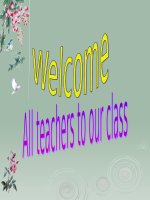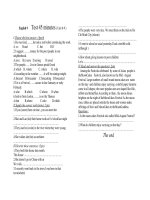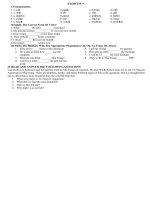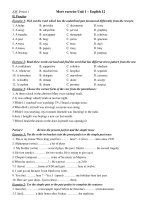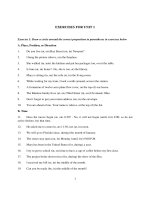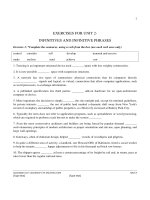Architecture English Exercise Unit 02
Bạn đang xem bản rút gọn của tài liệu. Xem và tải ngay bản đầy đủ của tài liệu tại đây (39.72 KB, 5 trang )
1
HOCHIMINH CITY UNIVERSITY OF ARCHITECTURE
Ms LY
[Type text] [Type text]
EXERCISES FOR UNIT 2-
INFINITIVES AND INFINITIVE PHRASES
Exercise 1: *Complete the sentences, using a verb from the box (use each verb once only)
control consider sell develop transmit and receive
make enclose send achieve run
1. Trussing is an important structural device used ________ spans with less weighty construction.
2. It is now possible ________ space with suspension structures.
3. A network has two types of connections: physical connections that let computers directly
________________ signals and logical, or virtual, connections that allow computer applications, such
as word processors, to exchange information.
4. A published specification lets third parties ________ add-on hardware for an open-architecture
computer or device.
5. More important, the decision to simply________ the site outright and, except for minimal guidelines,
let private interests ________ the use of public land marked a dramatic shift away from New York's
record of exemplary stewardship of public properties, so effectively exercised at Battery Park City.
6. Typically the term does not refer to application programs, such as spreadsheets or word processing,
which are required to perform a task but not to make the system ________.
7. Even the most conservative architects and builders are being forced by popular demand ________
such elementary principles of modern architecture as proper orientation and site-use, open planning, and
large wall-openings.
8. Gateways, often of elaborate design, helped ________ crowds of worshipers and pilgrims.
9. In quite a different area of activity, a landlord, one Howard Offit of Baltimore, hired a social worker
to help his tenants ________ happy adjustments to life in his thousand red brick row houses.
10. The shipper agrees ________ at least a certain percentage of its freight by rail and, in return, pays at
rates lower than the regular railroad rates.
2
HOCHIMINH CITY UNIVERSITY OF ARCHITECTURE
Ms LY
[Type text] [Type text]
Exercise 2: Express each question and answer as one sentence, using to + infinitive
(note that you will need to change some words)
1. Q : Why do you go to the beach every weekend ?
A : Because I like swimming.
She _________________________________________________________________ .
She goes to the beach every weekend to swim.
2. Q : Why did you move to London ?
A : I want to find work.
He ____________________________________________________________________ .
3. Q : Why are you leaving home ?
A : I’m going to university in Birmingham.
She ____________________________________________________________________ .
4. Q : Why are you having a party ?
A : It’s my thirtieth birthday, and I want to celebrate it .
He _____________________________________________________________________ .
5. Q :Why do you get up at six every morning ?
A : I do my training then.
She ______________________________________________________________________ .
6. Q : Why are you going out ?
A : I want to telephone my mother.
He ______________________________________________________________________ .
7. Q : Why are you saving money ?
A : We want to buy a car.
They _______________________________________________________________________ .
3
HOCHIMINH CITY UNIVERSITY OF ARCHITECTURE
Ms LY
[Type text] [Type text]
8. Q : Why are you going to Egypt ?
A : We want to visit Ali’s parents .
They ________________________________________________________________________.
9. Q : Why did you buy a new suit ?
A : I want to wear it at the office party.
He __________________________________________________________________________ .
10. Q : Why did you buy a video recorder ?
A : We want to record the World Cup Final.
They______________________________________________________________________ .
Exercise 3: Rewrite these sentences, starting with the words given. You will need to change some
words
1. Why did he ask that question? It was very strange.
That ______________________________________________________________________ .
That was very strange question to ask.
2. Thank you for visiting Janice in hospital. It was very kind.
It _________________________________________________________________________ .
It was very kind of you to visit Janice in hospital.
3. Why did he make that remark? It was very rude. That __________________________
4. I enjoyed flying the plane. It was very exciting. It _____________________________
5. I’m pleased I saw her again. It was quite a surprise. It _____________________________
6. John gave them 100. It was very generous. It _____________________________
7. I couldn’t drive the car. It was very difficult. It _____________________________
8. Why did you visit that place? It was very odd. That ___________________________
9. Why did he do that? It was very silly. It _____________________________
10 He shouldn’t have driven the car like that. It was stupid. It _________________________
4
HOCHIMINH CITY UNIVERSITY OF ARCHITECTURE
Ms LY
[Type text] [Type text]
Exercise 4: Choose the correct answer
1. “I can hear the wood crackle”. In this sentence, “crackle” is used as ___________ .
A. an adjective to modify the noun wood B. a noun to be object the verb hear
C. a subjective complement D. an objective complement
2. ‘It is very difficult to avoid hitting animals on the road at night”. The underlined phrase is used as
________.
A. a noun phrase to be an objective complement
B. an infinitive phrase used as an adverb to modify the adjective difficult
C. an infinitive phrase used as a modifier of purpose
D. an object
3. “He decided to put broken glass on top of his wall to prevent boys climbing over it “.The underlined
phrase is used as ___________ .
A. a modifier of purpose B. an objective complement
C. a subjective complement D. an object
4. “He decided to put broken glass on top of his wall to prevent boys climbing over it “.The underlined
phrase is used as ___________ .
A. a modifier of purpose B. an objective complement
C. a subjective complement D. an object
5. “They expected us to do this job for nothing”. The underlined phrase is used as __________.
A. a modifier of purpose B. an objective complement
C. a subjective complement D. an object
Exercise 5: Read and recognize all the infinitive phrases, prepositional phrases and their functions in
the following text
COLOUR IN HISTORICAL ARCHITECTURE
Any objects in the nature we have seen have a certain colour. Colour is the characteristic of
object which enables us to distinguish one object from the other, to judge the development as well as the
nature of object. In the process of life, Man always contacts with colour world. The lack of colour would
5
HOCHIMINH CITY UNIVERSITY OF ARCHITECTURE
Ms LY
[Type text] [Type text]
make the human life dull. This is very reason why a well-known French painter has written it “colour is
as necessary for life as water and fire”. The love of colour encourages Man to study and understand the
nature of colour, producing many kind of colour material, using colour in all fields.
In architectural field colour have used since long ago decorate projects. Decoration closely
attached to the knowledge of colour. Besides, due to the influence of religion and art, the principle of
using colour has been altered according to the development of stages of architecture. In ancient times
colour was used with a meaning as symbol. The projects in Babylon epoch, the Chinese Palaces , the
temples in India, Japan, Arab, Greece have showed this. For example The projects in Babylon has
storeys painted in different colour: black, red orange, yellow, green, blue, white which were the symbol
of seven planets of the sky.
The matter of colour harmony is always a center point of painter circles, urban decorators,
architects traditional architecture of Vietnam link harmoniously to nature landscapes. The colour of
project embellishes the natural and on the other hand the colours of trees, mountains, clouds, skies are
the most basic colours for projects.
A colour researcher assumed that each relation of colour harmony can’t help being a rule “ A
colour harmony naturally constitutes a rule but not a rule constitutes a colour harmony”.
THE END
